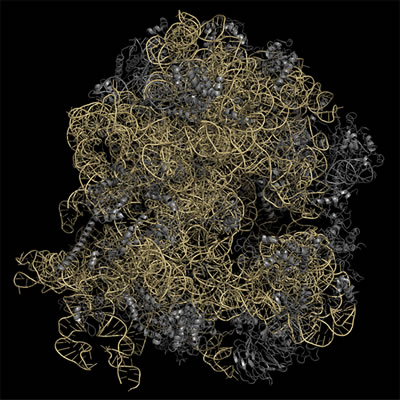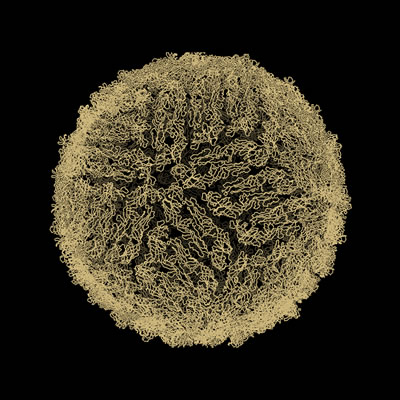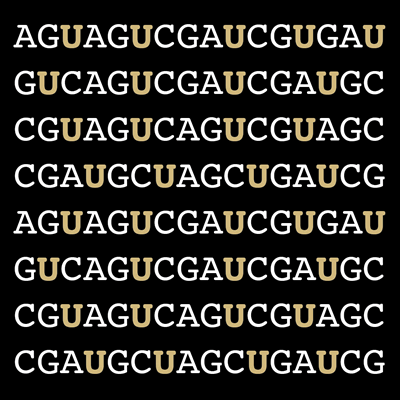Shared Content Block:
Styles -- hide parts of news feed
Shared Content Block:
Styles -- prevent images from going to 100 percent width on mobile
Research
The objective of the RNA Bioscience Initiative is to understand the role of RNA in biology, engage in collaborative research, create a fluid pipeline from basic science to clinical diagnostics and therapeutics, and train the next generation of RNA researchers.
Investigators on the CU Anschutz campus have already made important discoveries in the field, covering RNA structure-function, RNA biogenesis, mechanisms of regulation by non-coding RNAs, non-coding RNAs in disease, diagnostics, and therapeutics, cutting-edge RNA technologies and advanced genome-wide computational methods.
The RNA Bioscience Initiative continues to make substantial and sustained contributions to four major research areas:
Faculty
A principal aim of the RNA Bioscience Initiative is to foster a collaborative community that supports RNA research within a diverse, multidisciplinary group of scientists and physicians.
The RBI draws its faculty primarily from the University of Colorado Anschutz Medical Campus – School of Medicine, School of Dental Medicine and Skaggs School of Pharmacy and Pharmaceutical Sciences. These faculty comprise investigators from 11 different departments and 19 divisions. In addition, a small number of RBI faculty are drawn from other institutions, including CU Boulder, CU Denver, CSU, National Jewish Health, Metropolitan State University of Denver, and Loyola Marymount University.
To join the RBI faculty, please contact David Bentley, RBI co-director, at [email protected].
Meet the RBI Leadership Team
RBI Faculty, A – Z
Joan Hooper Research
Hong Li Research
Trevor Williams Research
Hong Li Research
Trevor Williams Research
| Faculty Name | University/Campus | School | Department/Division | E-mail Address | Lab Website |
| Scott Alper, PhD | CU Anschutz | Medicine | Immunology and Microbiology | [email protected] | Alper Lab |
| Tom Anchordoquy, PhD | CU Anschutz | Pharmacy/Pharmaceutical Sciences | Pharmaceutical Sciences | [email protected] | Tom Anchordoquy Research |
| Steven Anderson, PhD | CU Anschutz | Medicine | Pathology | [email protected] | Anderson Lab |
| Bruce Appel, PhD | CU Anschutz | Medicine | Pediatrics/Developmental Biology | [email protected] | Appel Lab |
| Yael Aschner, MD | CU Anschutz | Medicine | Medicine/Pulmonary Sciences & Critical Care | [email protected] | Yael Aschner Research |
| Rocky Baker, PharmD | CU Anschutz | Medicine | Immunology and Microbiology | [email protected] | Rocky Baker Research |
| Linda Barlow, PhD | CU Anschutz | Medicine | CDB | [email protected] | Linda Barlow Research |
| David Barton, PhD | CU Anschutz | Medicine | Immunology and Microbiology | [email protected] | David Barton Research |
| Richard Benninger, PhD | CU Anschutz | Medicine | Center for Bioengineering | [email protected] | Benninger Lab |
| David Bentley, PhD | CU Anschutz | Medicine | BMG | [email protected] | Bentley Lab |
| Joshua Black, PhD | CU Anschutz | Medicine | Pharmacology | [email protected] | Black Lab |
| Joe Brzezinski, PhD | CU Anschutz | Medicine | Medicine/Ophthalmology | [email protected] | Brzezinski Lab |
| Matthew Burchill, PhD | CU Anschutz | Medicine | Medicine/Gastroenterology and Hepatology | [email protected] | Burchill Lab |
| Eric Clambey, PhD | CU Anschutz | Medicine | Medicine/Anesthesiology | [email protected] | Clambey Lab |
| Adela Cota-Gomez, PhD | CU Anschutz | Medicine | Medicine/Pulmonary Sciences & Critical Care | [email protected] | Cota-Gomez Lab |
| Howard Davidson, PhD | CU Anschutz | Medicine | Pediatrics/BDC | [email protected] | Howard Davidson Research |
| Peter Dempsey, PhD | CU Anschutz | Medicine | Pediatrics/Developmental Biology | [email protected] | Peter Dempsey Research |
| James Dylewski, DO | CU Anschutz | Medicine | Medicine/Nephrology | [email protected] | James Dylewski Research |
| Patricia Ernst, PhD | CU Anschutz | Medicine | Pediatrics/Hematology and Oncology | [email protected] | Ernst Lab |
| Thomas Evans, PhD | CU Anschutz | Medicine | CDB | [email protected] | Tom Evans Research |
| Katherine Fantauzzo, PhD | CU Anschutz | Dental Medicine | Oral and Craniofacial Biology | [email protected] | Fantauzzo Lab |
| Megan Filbin, PhD | Metropolitan State University of Denver | College of Letters, Arts and Sciences | Chemistry and Biochemistry | [email protected] | Filbin Lab |
| Heide Ford, PhD | CU Anschutz | Medicine | Pharmacology | [email protected] | Ford Lab |
| Rachel Friedman, PhD | CU Anschutz | Medicine | Immunology and Microbiology | [email protected] | Rachel Friedman Research |
| Austin Gillen, PhD | CU Anschutz | Medicine | Medicine/Hematology | [email protected] | Austin Gillen Research |
| Berenice Gitomer, PhD | CU Anschutz | Medicine | Medicine/Nephrology | [email protected] | Berenice Gitomer Research |
| Eva Grayck, MD | CU Anschutz | Medicine | Pediatrics/Critical Care | [email protected] | |
| Kirk Hansen, PhD | CU Anschutz | Medicine | BMG | [email protected] | Hansen Lab |
| Jay Hesselberth, PhD | CU Anschutz | Medicine | BMG | [email protected] | Hesselberth Lab |
| Joan Hooper, PhD | CU Anschutz | Medicine | CDB | [email protected] | |
| Elena Hsieh, MD | CU Anschutz | Medicine | Pediatrics/Allergy and Immunology | [email protected] | Hsieh Lab |
| Ethan Hughes, PhD | CU Anschutz | Medicine | CDB | [email protected] | Hughes Lab |
| Sujatha Jagannathan, PhD | CU Anschutz | Medicine | BMG | [email protected] | Jagannathan Lab |
| Aaron Johnson, PhD | CU Anschutz | Medicine | BMG | [email protected] | Johnson Lab |
Craig Jordan, PhD | CU Anschutz | Medicine | Hematology | [email protected] | Jordan Lab |
| Peter Kabos, MD | CU Anschutz | Medicine | Medicine/Oncology | [email protected] | Kabos Lab |
| Ross Kedl, PhD | CU Anschutz | Medicine | Immunology and Microbiology | [email protected] | Ross Kedl Research |
| Melanie Koenigshoff, MD, PhD | CU Anschutz | Medicine | Medicine/Pulmonary Sciences & Critical Care | [email protected] | Melanie Koenigshoff Research |
| T. Rajendra Kumar, PhD | CU Anschutz | Medicine | OB/GYN | [email protected] | Kumar Lab |
| Laurel Lenz, PhD | CU Anschutz | Medicine | Immunology and Microbiology | [email protected] | Laurel Lenz Research |
| Hong Li, PhD | CU Anschutz | Dental Medicine | Oral and Craniofacial Biology | [email protected] | |
| Traci Lyons, PhD | CU Anschutz | Medicine | Medicine/Oncology | [email protected] | Traci Lyons Research |
| Martin McCarter, MD | CU Anschutz | Medicine | Medicine/Surgery-Surgical Oncology | [email protected] | Martin McCarter Research |
| Timothy McKinsey, PhD | CU Anschutz | Medicine | Medicine/Cardiology | [email protected] | McKinsey Lab |
| Michael McMurray, PhD | CU Anschutz | Medicine | CDB | [email protected] | McMurray Lab |
| Tem Morrison, PhD | CU Anschutz | Medicine | Immunology and Microbiology | [email protected] | Tem Morrison Research |
| Christian Mosimann, PhD | CU Anschutz | Medicine | Pediatrics/Developmental Biology | [email protected] | Mosimann Lab |
| Karen Moulton, MD | CU Anschutz | Medicine | Medicine/Cardiology | [email protected] | Karen Moulton Research |
| Kathryn Mouzakis, PhD | Loyola Marymount University | College of Science and Engineering | Chemistry and Biochemistry | [email protected] | Mouzakis Lab |
| Neelanjan Mukherjee, PhD | CU Anschutz | Medicine | BMG | [email protected] | Mukherjee Lab |
| James Nichols, PhD | CU Anschutz | Dental Medicine | Oral and Craniofacial Biology | [email protected] | Nichols Lab |
| Erin Nishimura, PhD | CSU | College of Natural Sciences | Biochemistry & Molecular Biology | [email protected] | Nishimura Lab |
| Lee Niswander, PhD | CU Boulder | College of Arts & Sciences | MCDB | [email protected] | Niswander Lab |
| Chad Pearson, PhD | CU Anschutz | Medicine | CDB | [email protected] | Pearson Lab |
| Christopher Phiel, PhD | CU Denver | College of Liberal Arts and Sciences | Integrative Biology | [email protected] | Phiel Lab |
| Eric Pietras, PhD | CU Anschutz | Medicine | Medicine/Hematology | [email protected] | Pietras Lab |
| J. David Port, PhD | CU Anschutz | Medicine | Medicine/Cardiology | [email protected] | Port Lab |
| Rytis Prekeris, PhD | CU Anschutz | Medicine | CDB | [email protected] | Prekeris Lab |
| Srinivas Ramachandran, PhD | CU Anschutz | Medicine | BMG | [email protected] | Ramachandran Lab |
| Tania Reis, PhD | CU Anschutz | Medicine | Medicine/Endocrinology | [email protected] | Tania Reis Research |
| Marino Resendiz, PhD | CU Denver | College of Liberal Arts & Sciences | Chemistry | [email protected] | Resendiz Lab |
| Diego Restrepo, PhD | CU Anschutz | Medicine | CDB | [email protected] | Restrepo Lab |
| Jennifer Richer, PhD | CU Anschutz | Medicine | Pathology | [email protected] | Richer Lab |
Kent Riemondy, PhD | CU Anschutz | Medicine | BMG | [email protected] | Kent Riemondy Research |
| Olivia Rissland, PhD | CU Anschutz | Medicine | BMG | [email protected] | Rissland Lab |
| Mario Santiago, PhD | CU Anschutz | Medicine | Medicine/Infectious Disease | [email protected] | Mario Santiago Research |
| Stephen Santoro, PhD | CU Anschutz | Medicine | Pediatrics/Developmental Biology | [email protected] | Stephen Santoro Research |
| Carol Sartorius, PhD | CU Anschutz | Medicine | Pathology | [email protected] | Sartorius Lab |
| Rebecca Schweppe, PhD | CU Anschutz | Medicine | Medicine/Endocrinology | [email protected] | Rebecca Schweppe Research |
| Yiqun Shellman, PhD | CU Anschutz | Medicine | Medicine/Dermatology | [email protected] | Yiqun Shellman Research |
| Matthew Sikora, PhD | CU Anschutz | Medicine | Pathology | [email protected] | Sikora Lab |
| Lori Sussel, PhD | CU Anschutz | Medicine | Pediatrics/BDC | [email protected] | Sussel Lab |
| Matthew Taliaferro, PhD | CU Anschutz | Medicine | BMG | [email protected] | Taliaferro Lab |
| Beth Tamburini, PhD | CU Anschutz | Medicine | Medicine/Gastroenterology and Hepatology | [email protected] | Tamburini Lab |
| Matt Taylor, MD, PhD | CU Anschutz | Medicine | Medicine/Cardiology | [email protected] | Matthew Taylor Research |
| Linda van Dyk, PhD | CU Anschutz | Medicine | Immunology and Microbiology | [email protected] | Linda van Dyk Research |
| Sujatha Venkataraman, PhD | CU Anschutz | Medicine | Pediatrics/Hematology and Oncology | [email protected] | Sujatha Venkataraman Research |
| M. Natalia Vergara, PhD | CU Anschutz | Medicine | Medicine/Ophthalmology | [email protected] | Natalia Vergara Research |
| Rajeev Vibhakar, MD, PhD | CU Anschutz | Medicine | Pediatrics/Hematology and Oncology | [email protected] | Rajeev Vibhakar Research |
| Quentin Vicens, PhD | CU Anschutz | Medicine | BMG | [email protected] | Quentin Vicens Research |
| Beat Vogeli, PhD | CU Anschutz | Medicine | BMG | [email protected] | Vogeli Lab |
| Mary Weiser-Evans, PhD | CU Anschutz | Medicine | Medicine/Nephrology | [email protected] | Mary Weiser-Evans Research |
| Trevor Williams, PhD | CU Anschutz | Dental Medicine | Oral and Craniofacial Biology | [email protected] | |
| Gongyi Zhang, PhD | CU Anschutz | Medicine | Immunology and Microbiology | [email protected] | Gongyi Zhang Research |
| Rui Zhao, PhD | CU Anschutz | Medicine | BMG | [email protected] | Zhao Lab |
| Han Zhu, Ph.D. | CU Anschutz | Medicine | Pediatrics/Developmental Biology | [email protected] |



